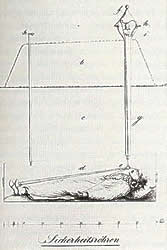
Johann Taberger designed this “safety coffin” in 1829, to preserve people who had been mistakenly buried alive. Strings were attached to the body’s head, hands, and feet, connected to a bell that would alert the cemetery’s nightwatchman, who could use a bellows to pump air into the coffin until it could be dug up.
Such devices were popular during the cholera epidemics of the 18th and 19th centuries — European graves were rigged variously with bells, flags, ladders, and escape hatches. There’s no evidence that they ever saved anyone, and they nearly killed some of their inventors: During a demonstration in 1897, a chamberlain to the tsar of Russia buried his assistant, waited, and finally realized that the signaling system had failed. The assistant was saved, but the marketing campaign was DOA.


